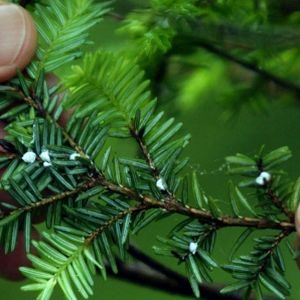
(Host) The recent discovery of an insect that destroys hemlock trees is causing some alarm in southern Vermont. Now, researchers are hoping to halt the spread of the hemlock woolly adelgid by introducing an adelgid-eating beetle.
VPR’s Susan Keese reports.
(Keese) On a steep wooded ledge above the Connecticut River in Vernon, David Mausel marks a small evergreen with orange spray paint.
(Paint can shaking, then sprays)
(Keese) Mausel is an entomologist at U-Mass Amherst working on a biological answer to the problem of hemlock death from woolly-adelgid. He holds out a branch of the hemlock he’s marked. The needles are tufted with a waxy white fuzz – the so-called wool that gives the tiny, nutrient -sucking insect its name.
(Mausel) "So as you could see there’s an adelgid practically at the base of every needle. That’s an outbreak situation, where the trees are not able to sustain that many pests."
(Keese) Adelgids were accidentally exported from Japan to Virginia in the 1950s. Because they have no natural enemies in the eastern U.S., they’ve spread unchecked, devastating tracts of hemlocks in the south. They’ve been killing trees as far north as Connecticut and Massachusetts. But Vermont’s cold temperatures kept them at bay – until recently.
(Burns) "We had a couple of warm, winters in a row and we think that’s what broke the ice."
(Keese) Barbara Burns is a forest protection specialist for the Vermont Division of Forests. She and a handful of other foresters are here for the release of 202 tiny adelgid-eating beetles Fedexed from Seattle.
(Sound of cooler opening)
(Keese) They’re waiting in a cooler at Mausel’s feet.
(Mausel ) all right….(jars jostling)
(Keese) Hemlock woolly adelgids are native to the Pacific Northwest. But they don’t kill trees there. Mausel says it’s because they’ve co-evolved with predatory insects that keep the populations in balance.
(Mausel) "And one of the most common and ubiquitous ones are this laricobius nigritis."
(Keese) The predatory laricobius beetles are on wads of wood shavings, 50 to a wad, each about the size of a pin head. Mausel places the shavings with the beetles on one of the marked branches
(Tap tap tap)
(Mausel) Come on… allright!
(Keese) Immediately the tiny beetles start moving.
(Mausel) "So you might be able to see this one start feeding immediately. I believe it is. If you come around and look at it, it tucked right under"
(Keese) Scientists say these beetles only eat adelgids, so they won’t become a problem in their own right. They’ve introduced the beetles in 17 or 18 states since 2003. They’ve reproduced and slowly increased in numbers and territory. But six years out it’s still too soon to say whether they’ve improved the hemlocks’ health. It could take decades to shift the balance.
(Mausel) "These beetles haven’t proven anything yet, only that they show promise."
(Keese) The researchers want to find out if Laricobius beetles can even survive Vermont’s cold winters. This is one of only two release sites in the state, both in Vernon. Scientists will be monitoring them closely-with a little luck, for a long time to come.
For VPR news, I’m Susan Keese.
(Mausel) Look at that, that thing’s feeding! Five degrees Celsius. You gotta love it.